
Gwalior is a major city in the central Indian state of Madhya Pradesh; it lies in northern part of Madhya Pradesh and is one of the Counter-magnet cities. Located 343 kilometres (213 mi) south of Delhi, the capital city of India, 120 kilometres (75 mi) from Agra and 414 kilometres (257 mi) from Bhopal, the state capital, Gwalior occupies a strategic location in the Gird region of India. The historic city and its fortress have been ruled by several historic Indian kingdoms. From the Kachchhapaghatas in the 10th century, Tomars in the 13th century, it was passed on to the Mughal Empire, then to the Maratha in 1754, and the Scindia Dynasty of Maratha Empire in the 18th century. In April 2021, It was found that Gwalior had the best air quality index amongst the 4 major cities in Madhya Pradesh.
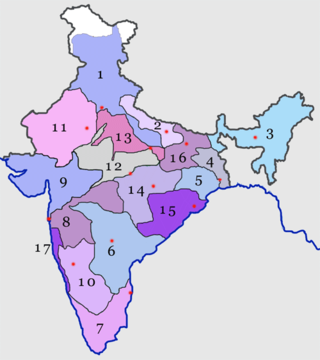
The North Central Railway is one of the 19 railway zones in India. The largest railway station in NCR is Kanpur Central. It is headquartered at Prayagraj and comprises three divisions: Prayagraj, Jhansi, and Agra of the erstwhile Northern Railway, Jhansi division of the erstwhile Central Railway, and new Agra division.
Sabalgarh is a municipality in Morena district in the Indian state of Madhya Pradesh.

The 12779 / 12780 Goa Express is a daily superfast train run by Indian Railways connecting Vasco da Gama and Hazrat Nizamuddin in New Delhi. It is one of the high priority superfast trains of Indian Railways and additionally, a very important train for Hubli division of South Western Railway.
The Taj Express was started in 1964 to serve tourists traveling from Delhi to Agra. It reduced the traveling time from over three hours to around two and a half hours. Taj Express was started along the lines of Deccan Queen- which ran as a high-speed commuter-special train between Pune Junction and CSMT Mumbai – and provided a quick and comfortable journey between Agra and Delhi. It was a very popular train especially among foreign tourists, before the Bhopal Shatabdi was introduced in 1988. The train was later extended up to Gwalior, then to Jhansi in 2006. It was named after Taj Mahal

Nagpur Junction is a railway station in Nagpur, in the Indian state of Maharashtra. It is an important junction station on the Howrah–Mumbai and Delhi–Chennai trunk line of the Indian Railways. It belongs to the A1 category of railway stations and is one of the top 100 stations of the Indian Railways system in terms of total bookings.

Birlanagar Junction railway station is a small railway junction in Gwalior city, Madhya Pradesh. Its code is BLNR. It serves Gwalior city. The station consists of three platforms. The platforms are not well sheltered. It lacks many facilities including water and sanitation.
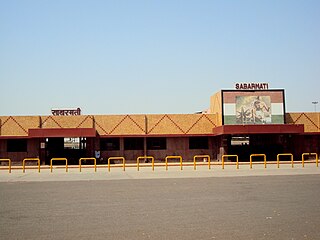
Sabarmati Junction railway station is a junction station of the Indian Western Railway in Ahmedabad, Gujarat. The station is six kilometres (3.7 mi) from the main Ahmedabad Junction railway station on the Ahmedabad–Delhi main line, at Dharamnagar near the Sabarmati Ashram. Sabarmati Junction has 2 tracks, the Mehsana line, and the Botad line, in addition to the main broad-gauge line for trains departing from Ahmedabad. The station has a dedicated rail yard for passenger trains, and was proposed in 2010 for development as an additional terminal for Delhi-bound trains.
The Hazrat Nizamuddin - Habibganj Express is a mail/express train of Indian Railways, which runs between Hazrat Nizamuddin railway station of Delhi, the capital city of India and Habibganj of Bhopal, the capital city of Central Indian state, Madhya Pradesh. The train is India's first ISO certified train. The train is known for its facilities, such as a coffee vending machine, mini pantry, library, and GPS. The train is also known for its maintenance and punctuality.
The 12189 / 12190 Mahakoshal Express is a daily Express train of the Indian Railways, which runs between Jabalpur Junction railway station of Jabalpur, one of the important cities and military cantonment hub of the Central Indian state Madhya Pradesh and Hazrat Nizamuddin railway station of Delhi, the capital city of India.

Jhansi Junction railway station is a major railway junction in the city of Jhansi in Bundelkhand region of Uttar Pradesh. It is one of the busiest and largest railway stations in India. It hosts various trains of Indian Railways like the Gatimaan Express, which is the fastest train of India, as well as others like Bundelkhand Express. It is a major halt for various important trains of Indian Railways like five sets of Rajdhani Express bound for Mumbai, Chennai, Bengaluru, Hyderabad etc. One set of Bhopal Shatabdi Express, three Duronto Express trains, Punjab Mail one of the oldest running trains in India, Kerala Express, Karnataka Express, etc.

Gaya Junction railway station is a junction station serving the city of Gaya, the headquarters of Gaya district and Magadh Division in the Indian state of Bihar. Gaya is in the Pandit Deen Dayal Upadhyaya railway division of the East Central Railway zone. Grand Chord rail-line that connects Howrah and New Delhi passes through Gaya. It lies between Pandit Deen Dayal Upadhyaya Junction on the Delhi side and Dhanbad Junction on the Howrah side. It is located at 24°48′13″N84°59′57″E. It has an elevation of 117 metres (384 ft). Gaya is connected with most of the states through rail network. Very few trains do-not stop here- sealdah duranto, bhubaneswar duranto, jharkhand sampark kranti and Odisha sampark kranti. There are also two other broad-gauge train lines from Gaya, one to Patna and the other to Kiul Junction. The city has two major railway stations: Gaya Junction & Manpur Junction. Gaya is well connected with Patna, Jehanabad, Biharsharif, Rajgir, Islampur, Nawada, Dehri on sone through daily passenger and express train services.
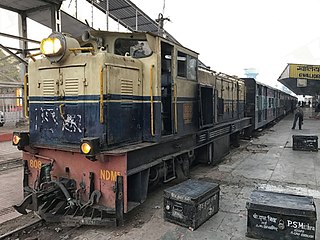
Gwalior Light Railway (GLR) or Maharaja Railway was a 2 ft narrow-gauge railway network in Gwalior. It was set up for Gwalior State during the times of British India. Until its closure in 2020, the railway was the longest 2 ft gauge railway in the world.

Madgaon Junction Railway Station is a railway junction and major station on the Indian Railways network, specifically on the South Western Railway line to Vasco da Gama, Goa and the Konkan Railway, in Madgaon, Goa, India. The station is progressing by getting electrified and double-tracked with the addition of new platforms.
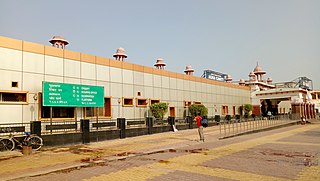
The Agra–Bhopal section is a railway line connecting, Agra, one of large city in Uttar Pradesh, and Bhopal, capital of the Indian state of Madhya Pradesh. This 508 km (316 mi) track is part of the Delhi–Chennai line. The line is under the jurisdiction of North Central Railway and West Central Railway.

The New Delhi–Chennai main line is a railway line connecting Chennai and Delhi cutting across southern part of the Eastern Coastal Plains of India, the Eastern Ghats, the Deccan Plateau and the Yamuna valley. It covers a distance of 2,182 kilometres (1,356 mi) across Delhi, Haryana, Uttar Pradesh, Rajasthan, Madhya Pradesh, Maharashtra, Telangana, Andhra Pradesh and Tamil Nadu. The route is used by the Grand Trunk Express and as such is referred to by many as the Grand Trunk Route.

The 12049 / 12050 Gatiman Express is India's first semi-high speed train that runs between Delhi and Jhansi. It takes 4 hours 25 minutes to cover the 403 km (250 mi) journey from Hazrat Nizamuddin to Virangana Lakshmibai Jhansi Junction railway stations with an average speed of 91 km/h (57 mph).

Guna Junction railway station is a main railway station in Guna district, Madhya Pradesh. Its code is GUNA. It serves Guna city. The station consists of three platforms. The platforms are well sheltered. It has many facilities including water and sanitation.
Ambikeshwar railway station is a small railway station in Gwalior district, Madhya Pradesh. Its code is ABE. It serves Ambikeshwar village. The station consists of a single platform. The platform is not well sheltered. It lacks many facilities including water and sanitation.
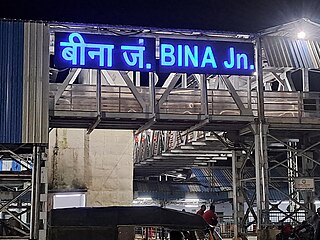
Bina Junction railway station is a railway junction in the Indian state of Madhya Pradesh. It is part of the Bhopal division of West Central Railway. Bina Junction serves the city of Bina, along with Bundelkhand and Malwa. Bina Junction has six platforms.


















